Antibody data
- Antibody Data
- Antigen structure
- References [0]
- Comments [0]
- Validations
- Western blot [1]
- Immunohistochemistry [2]
- Flow cytometry [2]
- Other assay [1]
Submit
Validation data
Reference
Comment
Report error
- Product number
- PA5-25804 - Provider product page

- Provider
- Invitrogen Antibodies
- Product name
- Clathrin Heavy Chain Polyclonal Antibody
- Antibody type
- Polyclonal
- Antigen
- Synthetic peptide
- Description
- This antibody is predicted to react with bovine, mouse and rat based on sequence homology.
- Reactivity
- Human
- Host
- Rabbit
- Isotype
- IgG
- Vial size
- 400 µL
- Concentration
- 0.25 mg/mL
- Storage
- Store at 4°C short term. For long term storage, store at -20°C, avoiding freeze/thaw cycles.
No comments: Submit comment
Supportive validation
- Submitted by
- Invitrogen Antibodies (provider)
- Main image
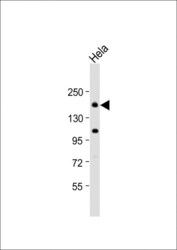
- Experimental details
- Western blot analysis of Clathrin Heavy Chain in Hela whole cell lysate. Samples were incubated with Clathrin Heavy Chain polyclonal antibody (Product # PA5-25804) using a dilution of 1:1,000 followed by Goat Anti-Rabbit IgG, (H+L), Peroxidase conjugated at a dilution of 1:10,000. Lysates/proteins: 20 µg per lane. Predicted band size: 192 kDa. Blocking/Dilution buffer: 5% NFDM/TBST.
Supportive validation
- Submitted by
- Invitrogen Antibodies (provider)
- Main image
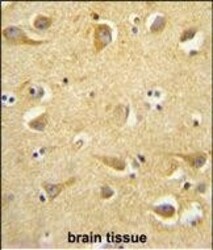
- Experimental details
- Immunohistochemistry analysis of Clathrin Heavy Chain in formalin fixed and paraffin embedded human brain tissue. Samples were incubated with Clathrin Heavy Chain polyclonal antibody (Product # PA5-25804) followed by peroxidase conjugation of the secondary antibody and DAB staining. This data demonstrates the use of this antibody for immunohistochemistry. Clinical relevance has not been evaluated.
- Submitted by
- Invitrogen Antibodies (provider)
- Main image
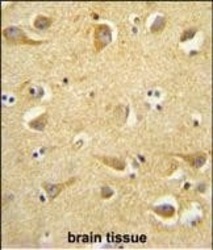
- Experimental details
- Immunohistochemistry analysis of Clathrin Heavy Chain in formalin fixed and paraffin embedded human brain tissue. Samples were incubated with Clathrin Heavy Chain polyclonal antibody (Product # PA5-25804) followed by peroxidase conjugation of the secondary antibody and DAB staining. This data demonstrates the use of this antibody for immunohistochemistry. Clinical relevance has not been evaluated.
Supportive validation
- Submitted by
- Invitrogen Antibodies (provider)
- Main image
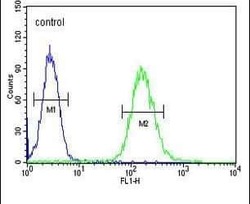
- Experimental details
- Flow cytometry analysis of HeLa cells using a CLTC polyclonal antibody (Product # PA5-25804) (right) compared to a negative control cell (left) at a dilution of 1:10-50, followed by a FITC-conjugated goat anti-rabbit antibody
- Submitted by
- Invitrogen Antibodies (provider)
- Main image
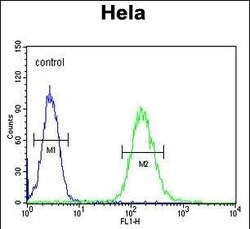
- Experimental details
- Flow cytometry of Clathrin Heavy Chain in Hela cells (right histogram). Samples were incubated with Clathrin Heavy Chain polyclonal antibody (Product # PA5-25804) followed by FITC-conjugated goat-anti-rabbit secondary antibody. Negative control cell (left histogram).
Supportive validation
- Submitted by
- Invitrogen Antibodies (provider)
- Main image
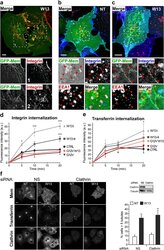
- Experimental details
- Figure 1 W13-induced PM tubules provide an internalization pathway for beta1-integrin. ( a ) COS1 cells grown on coverslips expressing the membrane marker GFP-mem were incubated with an anti-beta1-integrin rat antibody for 30 minutes at 4 degC to avoid endocytosis, followed by incubation for 10 minutes at 37 degC to allow internalization in the presence of W13 (20 min, 4.5 ug/ml). After fixation, beta1-integrin was detected with an Alexa-555 labeled anti-rat antibody, and images were acquired with a confocal microscope (Leica TCS SP5). The higher magnification insets show beta1-integrin localization in W13-induced tubules (green arrowheads). ( b , c ) Following the same procedure explained as in ( a ), beta1-integrin was detected with an Alexa-647 labeled anti-rat antibody and EEA1 with a specific antibody and the secondary Alexa-555 anti-mouse in untreated ( b ) or W13-treated cells ( c ). Insets show beta1-integrin in EEA1-positive endosomes (red arrowheads) ( b ) or in tubules (green arrowheads) ( c ) (bars, 10 um). ( d , e ) Quantification of internalized beta1-integrin ( d ) and transferrin ( e ), as explained in the Materials and Methods , in COS1 cells expressing GFP-mem or GFP-Rac1 G12V for the indicated conditions (W13t, cells presenting tubules; W13nt, cells without tubules). Mean values +- standard error of the mean (SEM) from three independent experiments are shown. Statistical significance between different conditions and the corresponding control was determined
 Explore
Explore Validate
Validate Learn
Learn Western blot
Western blot